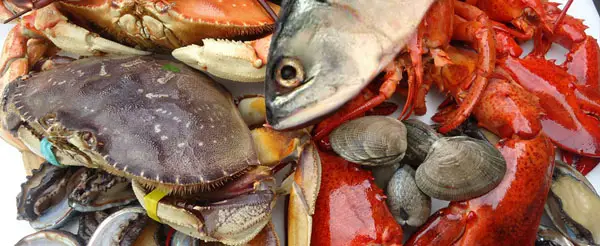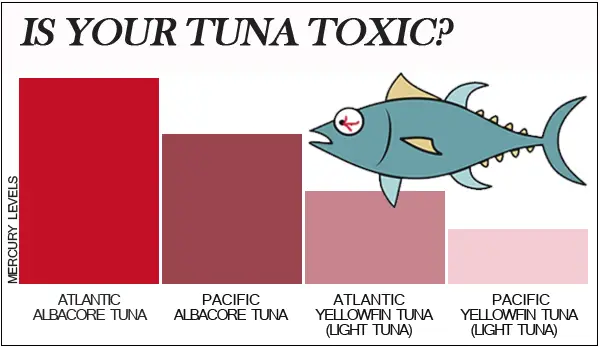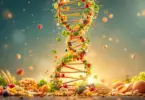4th March 2014
By Joshua Corn
Guest Writer for Wake Up World
Should we trust governmental health agencies when they assure us that eating seafood is safe?
In light of recurring oceanic contamination events such as industrial pollution, high mercury levels in seafood, massive oil leaks and nuclear power plant meltdowns, it’s become increasingly difficult to swallow the “all clear” advisories issued by the EPA and other governmental health agencies.
Health Benefits of Seafood
Studies suggest that the benefits of eating seafood are considerable. Fish and shellfish provide a rich source of high-quality protein and certain types of fish such as herring, lake trout, mackerel, salmon and sardines contain a rich supply of omega-3 fatty acids. Research studies suggest that omega-3s help to alleviate a wide variety of chronic health conditions, including allergies, cardiac arrhythmias, depression, irritable bowel syndrome, rheumatoid arthritis and dangerous blood clots. Studies have linked a high fish intake with a reduced mortality from coronary heart disease in prospective population studies.
[pro_ad_display_adzone id=”110028″]
Despite such widely accepted benefits, seafood can be hazardous to your health when contaminated with industrial chemicals like PCBs and dioxin, heavy metals such as methylmercury, petroleum products such as Exxon Valdeez and Deepwater Horizon and radioactivity from nuclear power plant meltdowns, as we saw with Three-Mile Island and Fukishima.
This all begs the question: In this highly contaminated world, is it still possible to find sustainable seafood that is high in disease-fighting omega-3 fats, yet low in environmental toxins?
After extensive research, I believe the answer is qualified “yes”— with one important caveat: The benefits of eating seafood clearly exceed the risks from toxic contaminants, provided the seafood consumed is low in those contaminants.
Mercury and Pregnant Women
Many consumers first became aware of the elevated levels of toxins in certain kinds of fish when the FDA and EPA warned that pregnant women and children should limit their consumption of canned tuna due to mercury contamination. Since the health warning, tuna sales have seen a steady decline with revenue losses of $150 million annually, according to the New York Times.
In 2004, the EPA and FDA issued a joint statement warning that “nearly all fish and shellfish contain traces of mercury.” The National Institutes of Health (NIH) acknowledged that exposure to this toxin “results principally from consumption by pregnant women of seafood contaminated by mercury.” In fact, between 316,000 and 637,000 children each year have cord blood mercury levels at levels associated with loss of IQ, which reduces their quality of life and “causes diminished economic productivity that persists over the entire lifetime of these children.”
The FDA and EPA have each warned pregnant women, women of childbearing age, nursing mothers and young children against eating king mackerel, shark, swordfish and tilefish due to high mercury levels. They also cautioned these groups to limit their consumption of albacore tuna to no more than six ounces per week.
Mercury and Everyone Else: Murkier Waters
Studies show that high levels of mercury exposure can harm children and adults. Extremely high mercury levels can permanently damage an adult’s brain and kidneys and lead to circulatory failure. There’s no argument that high levels of mercury in the diet can have deadly consequences. But what about mercury levels typically found in seafood? Do such levels pose a risk to healthy adults?
The answer to this question is not as clear-cut as it is in the case of the fetus or young child. For example, a study conducted in eight European countries and Israel that measured the association of mercury levels in toenail clippings and docosahexaenoic acid (DHA) levels in adipose tissue with the risk of a first myocardial infarction among men found that mercury levels were directly associated with the risk of myocardial infarction, and DHA levels were inversely associated with the risk.
It’s a tradeoff: the omega-3 fats in seafood are heart healthy, while the mercury is not. A high-mercury content can diminish the cardioprotective effect of fish. Since all seafood contains some mercury, the logical solution is to identify and consume a limited amount of low-mercury seafood, right?
Sorry Charlie – Tuna Isn’t the Answer
According to a 2007 EPA report, tuna is responsible for 39 percent of all mercury exposure from fish in the United States. Of this 39 percent, 18 percent comes from canned light tuna, also known as yellowfin, 10 percent from canned white tuna, or albacore, and 11 percent from fresh or frozen tuna.
But these numbers are deceptive: Even though canned light tuna accounts for almost double the total mercury exposure as canned albacore or white tuna, albacore/white tuna is actually much higher in mercury content. The reason is economic: Americans consume far more canned light tuna because of the lower price.
Atlantic and Pacific albacore tuna — canned and fresh — contain three times the mercury level found in Pacific and Atlantic light tuna. Atlantic tuna is higher in mercury than Pacific tuna. Therefore, light tuna (especially Pacific light tuna) makes a healthier choice than albacore tuna (especially Atlantic albacore tuna) with respect to mercury exposure risk. Consumer Reports found that on average, white (or albacore) varieties contained far higher levels of mercury than the “light” tuna: 0.427 ppm versus 0.071 ppm.
How much tuna can you safely eat? The EPA recommends that adult men limit consumption of tuna to 5 ounces of albacore (solid white) or 14.5 ounces of light tuna a week, based on an average mercury concentration of 0.5 ppm. (A can of tuna typically contains 5 to 6 ounces, including liquid.) I find this information a bit deceptive because the EPA’s calculations assume that you eat no other seafood at all. If you’d like a more personalized estimate based on your body weight, check out the Environmental Working Group’s online calculator.
Salmon Concerns
Polychlorinated biphenyls (PCBs) are carcinogenic chemicals released into the environment that also act as endocrine system disruptors. Recent studies have pointed to farmed salmon as being particularly vulnerable to PCB contamination. This is most likely due to farmed salmon being fed ground-up fish with high concentrations of PCBs in their fat and oils, according to three independent studies, including one conducted by the School of Public Health at the University of Illinois at Chicago.
Currently, more than 80 percent of the fresh salmon eaten in the U.S. is farmed. Studies show that some varieties of farmed salmon contain high levels of cancer-causing PCBs that come from the fishmeal and fish oil the salmon are fed. The good news: The global salmon farming industry is investigating ways to reduce PCB levels, but at this time, I strongly urge you to consume only wild salmon.
Seafood From Oil Spill Disaster Areas
Can you safely enjoy shrimp and other seafood from Gulf Coast waters after the BP Deepwater Horizon oil spill disaster?
According to Robert Dickey, director of the FDA Gulf Coast Seafood Laboratory and the agency’s Division of Seafood Science and Technology, the testing conducted in the aftermath of the spill, which is the most comprehensive in the history of the agency, continues to show that seafood caught in the gulf is safe to eat.
“The bottom line is that the seafood is as safe to consume now as it was before the spill,” Dickey said. “We’re back to background levels. We were in the fall (of 2010) shortly after the spill dissipated.”
I think it’s important to consider that while the FDA tests for a small group of petroleum contaminants that are known carcinogens, it doesn’t test for all of the hundreds of toxic compounds contained in oil.
“Folks are understandably concerned.” Finney noted. “But there are thousands of different compounds in oil and there’s no way we can monitor and analyze for every one of them.”
Given the uncertainties of Gulf of Mexico seafood safety, and the lack of comprehensive testing for the large number of petroleum and other chemical contaminants, I believe it’s prudent to avoid consuming seafood culled from this coastal region until further tests confirm its safety.
Does Your Tuna Glow-In-The-Dark?
It just might if it’s laced with radioactive waste from the 2011 Fukishima nuclear plant disaster!
Scientists at Stanford University and the French Institute for Radiological Protection and Nuclear Safety (IRSN) report that the likely doses of radioactivity ingested by humans consuming fish contaminated with radioactive waste from the Fukishima nuclear disaster is equal to or less than the radiological dosages associated with other commonly consumed foods, many medical treatments, air travel and other background sources:
“In estimating human doses of the Fukishima-derived radioactive cesium in Bluefin tuna, we found that heavy seafood consumers would receive radiation doses approximately equivalent to that from one dental x-ray. The resulting increased incidence of cancers would be expected to be essentially undetectable.”
Eating a fish dinner is equivalent to the radiation in one dental x-ray? And we’re supposed to believe this is safe? And what about the fact that the Fukushima leak continues to dump 300-400 tons of radioactive contaminated water into the Pacific every hour? Japanese scientists estimate Fukushima’s fallout at 20-30 times as high as the Hiroshima and Nagasaki nuclear bombings in 1945. Thanks, but no thanks. I’ll continue to avoid west coast seafood until I get the all-clear signal from reputable published studies.
Is Our Government Protecting Us?
I began this report by asking whether we should trust our government to protect us from consuming unsafe seafood. Here’s something to help you decide:
While she was Secretary of State, Hillary Clinton agreed to continue purchasing seafood from Japan after the Fukishima nuclear power plant meltdown, despite the fact that the food was not being tested for radioactive contamination. Independent testing in Japan showed 65 percent of the catches tested positive for cesium (a radioactive material). Rather than refuse to purchase the contaminated seafood, US food safety agencies simply raised the “acceptable level of radiation”.
Sorry, but I’m just not willing to risk my health or the health of my family on questionable politics that seem more favorable to industry than to US citizens.
Despite all of the concerns about the safety of fish and shellfish, I still highly advise you make sure you’re getting optimal daily doses of omega-3 fatty acids. For this reason, you may want to consider a high quality fish oil supplement. Make sure to pick a supplement that says it’s “molecullary distilled,” as this is currently the only purification process that renders most fish oil virtually toxin free, without damaging the delicate omega-3s.
I am currently working on a “Seafood Safety Guide” to help you select the healthiest and safest sustainable fish and shellfish. Stay tuned!
Previous articles by Joshua Corn:
- Death By Toothpaste – the Fluoride Myth
- Has Your Health Been Bought?
- The Great Vitamin-D Scam
- 5 Reasons to Avoid Plastic Containers
- Diet Drinks: The Biggest Marketing Scam of All Time?
- Antidepressants in Tap Water Linked to Autism
- 2013: The Year People Finally Start to Get It?
- 5 Good Reasons to Stop Drinking Soda… Immediately
- Guess What Kills One Person Every 19 Minutes?
About the author:
 Joshua Corn is the Editor-in-Chief of the natural health and wellness site, Live in the Now. Josh is a health freedom advocate and veteran of the natural health industry. He has been actively involved in the natural health movement for over 15 years, and has been dedicated to the promotion of health, vitality, longevity and natural living throughout his career.
Joshua Corn is the Editor-in-Chief of the natural health and wellness site, Live in the Now. Josh is a health freedom advocate and veteran of the natural health industry. He has been actively involved in the natural health movement for over 15 years, and has been dedicated to the promotion of health, vitality, longevity and natural living throughout his career.
Josh has successfully overcome several personal health challenges through natural means, and believes that sharing information can empower people to take control of their health so they can solve their own problems and live life to its fullest potential.
Josh is the founder and Editor-in-Chief of Live in the Now. Additionally he serves as CEO of SAN, a company that has been formulating premium dietary supplements since 1995. Josh is currently working on his first book about natural health, and gearing up to launch the Live in the Now radio show.
In addition to his work in the natural health field, Josh is an avid outdoorsman, yoga practitioner, animal lover and father of two sons who remind him every day to “live in the now”.
[pro_ad_display_adzone id=”110027″]
This article was republished with permission from Live in the Now, one of the fastest growing natural health newsletters. Visit LiveInTheNow.com to browse their complete library of articles, or join the nearly 60,000 readers subscribed to their Newsletter.








